When you cal the REW SPL meter you need to actually hook up the cab to the amp and the mic to the soundcard, you can't just use the loopback.
They were
Raise or lower the mic input gain until you are in the 120-130dB max level area.
I'll try this. Hopefully, that test start to audio delay problem will magically disappear.
What I don't get is how your levels on the input side could "go up" before you hear the sweep? This would indicate a monitor loop is on or wrong input/channel selection...
You could disconnect all the inputs and outputs and try to measure if the input meters go up you have an internal signal routing problem...
You could disconnect all the inputs and outputs and try to measure if the input meters go up you have an internal signal routing problem...
What I don't get is how your levels on the input side could "go up" before you hear the sweep?
I don't believe I said they did..
I don't believe I said they did..
I misunderstood:
Still, when I go in to measure, I click "Check Levels" there, it pops up the "Signal too Low" warning before any audio is played. Then, audio plays for a couple seconds and stops (same happens w/measurement sweep). Maybe I should set up a loop for REW to calculate for sound card delay option.
Are you running the REW beta code or something?
Latency thoughts.
If your SC bitrate is externally/manually set to a higher rate than REW you will fill the buffer before the impulse gets there so make sure 44.1 is set for the card and REW.
You may want to increase buffer sizes in REW prefs but I get by just fine on 32k.
Notice my card inverts polarity...

First objective for me would be to get the system measuring correctly with the loop back cable just after the calibration. Look at the impulse, polarity invert if necessary using check box in controls (upper right corner). The FR should be basically flat because you already have the calibration file in place.
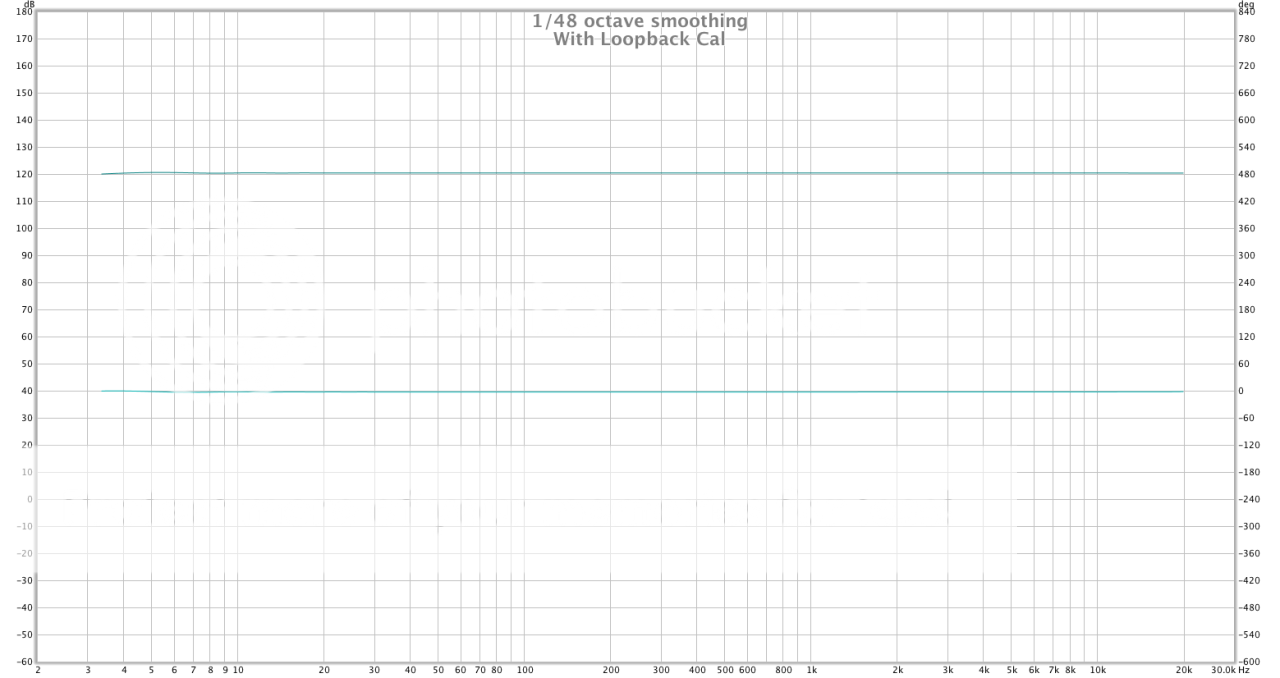
I misunderstood:
Yeah, levels don't go up until I hear audio (mic "hears" audio, too). I get that Low Level warning before I hear audio. Maybe it IS a latency thing..
Are you running the REW beta code or something?
Not that I know of - I didn't even know about it.
Latency thoughts.
If your SC bitrate is externally/manually set to a higher rate than REW you will fill the buffer before the impulse gets there so make sure 44.1 is set for the card and REW.
They're both set to 48k. I can try 44.1k next time.
You may want to increase buffer sizes in REW prefs but I get by just fine on 32k.
I currently have them set to 128k.
Notice my card inverts polarity...
An externally hosted image should be here but it was not working when we last tested it.
First objective for me would be to get the system measuring correctly with the loop back cable just after the calibration. Look at the impulse, polarity invert if necessary using check box in controls (upper right corner). The FR should be basically flat because you already have the calibration file in place.
An externally hosted image should be here but it was not working when we last tested it.
I'll try taking a measurement with the loop back cable and see what happens. Thanks for your help.
Looking at REW "support" forum I see:
9/10/12 Link
And back in 09' I see a claim from a user that Apple Java could not access Firewire sound device inputs...
I'd get rid of everything but the Firewire box and the Loopback cable and sort it out. Take a screen shot of the scope and save the REW file if it appears to be working, and we can go from there...
And then then JohnM goes on to say:On the V5 Soundcard Preferences tick the "Force Big-Endian" box and see if that helps.
9/10/12 Link
Unfortunately Apple's Java runtime has a bug that prevents Java applications accessing the inputs of multichannel soundcards (anything with more than a single stereo input). If your iMac has on-board line in and out that should work fine, though. Failing that the problem might not be present in Oracle's OpenJDK version of Java for OS X, Oracle Releases New Java Updates - Java SE 7 Update 6, JavaFX 2.2 and JavaFX Scene Builder 1.0, although I think Apple contributed code towards the project so they may have generously donated their bugs at the same time
And back in 09' I see a claim from a user that Apple Java could not access Firewire sound device inputs...
I'd get rid of everything but the Firewire box and the Loopback cable and sort it out. Take a screen shot of the scope and save the REW file if it appears to be working, and we can go from there...
Hi Crescendo,
I watched 3 you tube vids that were very helpful with setting up the mic and sound card,
Room EQ Wizard - Step 1 - Calibration - YouTube
Regards,
NS
I watched 3 you tube vids that were very helpful with setting up the mic and sound card,
Room EQ Wizard - Step 1 - Calibration - YouTube
Regards,
NS
Unlike the PLX series, the QSC PL380 is also a good LF amp.Yeah, I don't think we've ever had a gig with anything but 120V (15A or 20A) - with the exception of one gig last year off an MQ Power Whisperwatt generator.
So, I think I'd be more comfortable with 120V amps. I would, however, like to further educate myself on different power configurations (3 phase included) should the opportunity/conditions arise.
Most USA smaller venues use single phase power, two "hot" legs of 120 volts, 240 volts AC between the two legs. Power transformers have changed over the years, older transformers encountered may be 220-230 volts between legs.
Three phase power has three hot legs of 120 volts, nominally only 208 volts between them. The phase angle between the three legs allows the use of three phase motors, which won't run on single phase.
Back when I owned chain motors, had four single phase 120 volt hoists for certain venues lacking three phase, and a dozen 3 phase motors for "normal" concert venues.
When lifting a ton, the 120V chain motors drew near 20 amps, 10 or 12 AWG was needed for a 100 foot run or they would not pull the weight, while three of the same CM 3 phase motors could run on a 20 amp circuit using 14 gauge and not stall, even when slipping the protective clutch plates which slip above a 1 ton load. Two ton CM motors use the same motor/clutch, but twice the chain over a sheave to gain double the mechanical advantage.
Riggers hate pulling up 80 feet of doubled chain...
Some older three phase installations have a "wild leg" which can fluctuate wildly depending on the load on the three phases, won't damage a motor, but can fry gear when voltage on the "wild leg" drops to 60, or rises to 180 V. I hate it when that happens..
One problem with "old school" (non-switching power supply) amplifiers rated for "220" volts (ostensibly they can run off 208-240 volts) is the 208 volts between two hot legs of a three phase service may not allow full rated power from the amp. Some amps have different transformer taps to deal with the different voltages available, while many modern PSU designs deal with voltage change automatically.
One last observation, although an outlet may read 120 VAC when unloaded, different amp designs will “brown out” (dropping to 110V or even less) the service on peaks to a different degree, some amps that perform just fine on bench regulated 120V power don’t behave at all well in the real world of lower voltage at higher amperage peaks.
Sometimes the weight savings afforded in a switching PSU amp are completely offset by the heavier AWG cable needed to keep the voltage up, and the amp performing to spec.
Art Welter
Unlike the PLX series, the QSC PL380 is also a good LF amp.
PL340 as well (same series)? I ask because I'm using 8 ohm drivers (PL380: 8000W bridged into 4 ohms seems a bit too much for my drivers).. That amp looks like it would've been a winner had I purchased 4 ohm drivers (PL380: 2500W/ch @ 4 ohms).
The PL340 would give me 4000W bridged @ 4 ohms, which seems like a better bet. Still not the 6000W I was looking for, but like you said, this amp would probably give me more of what I need with similar (read 300W more per driver w/PL340) "on paper" PLX specs.
Hi Guys! All I have to say is OMG!. I have spent the last 2 plus weeks reading this thread from begining to end (slow reader, bad reading comprehension and lack of time) and have learned alot and but now have some questions.
First about the TH-18. I realize that this is a compromise between output/size/efficiency/extension. There are drivers that work ok and drivers that hold up well under extreme xmax. Due to AC limitations I am not too worried about max SPL per cab and more concerned with efficiency/depth/driver cost. If I read correctly I should wait for the finalized version with the additional throat comprssion for cheaper drivers. I believe the 18 Sound 18LW2400 is a good buget driver for this cab.
This might sound somewhat stupid but how low will this play. My gigs are mostly DJing school dances with pop music but my system gets used by other DJs that play mostly hip-hop. I occasionally play dubstep but realize that the extra cab volume needed to get the that low is just not worth it to me. Will this cab (driver dependent) play the bass in these songs?
<iframe width="420" height="315" src="http://www.youtube.com/embed/aJEzl31zL-I" frameborder="0" allowfullscreen></iframe>
<iframe width="560" height="315" src="http://www.youtube.com/embed/Dq_sGy4H_-k" frameborder="0" allowfullscreen></iframe>
The 2nd song I cant stand. All I am concerned with is the first bass drop of that song. I understand there is some lower stuff in it but I am not worried about that.
The "amp talk" from Art was very infomative. I Have 2
PLX3402s, 1 runs subs which are 1 reflex loaded with 2 RCF L18P300's and I add a 2nd reflex loaded with 2 P-Audio SD-18's on bigger gigs. Amp runs bridged and both cabs are wired in series (16 ohms). 2nd amp runs highs. I originally wanted to replace the sub amp with a RMX4040 or something similar but that changed on friday when I stumbled into a deal which consisted of a QSC PL218 and a PL 236, both for $525 out the door at a pawn shop. I was going to dedicate both PLX's to subs and use the PL236 on highs but after reading what Art has to say about the plx's I will probably replace them. Anyway that gets me to how much power can I run on a 15 amp ckt? I have run both PLX3602's close to clipping (one 4ohm stereo and one 8 ohm bridged) and a PLX2402 about half power (4 ohm stereo) from a 15 amp ckt but the voltage drop was pretty low and the sub amp did "brown out" at extreme levels as Art mentioned.
Sorry for the rambling, I am sure I will have some other questions soon.
Thanks and keep up the good work.
Dave
First about the TH-18. I realize that this is a compromise between output/size/efficiency/extension. There are drivers that work ok and drivers that hold up well under extreme xmax. Due to AC limitations I am not too worried about max SPL per cab and more concerned with efficiency/depth/driver cost. If I read correctly I should wait for the finalized version with the additional throat comprssion for cheaper drivers. I believe the 18 Sound 18LW2400 is a good buget driver for this cab.
This might sound somewhat stupid but how low will this play. My gigs are mostly DJing school dances with pop music but my system gets used by other DJs that play mostly hip-hop. I occasionally play dubstep but realize that the extra cab volume needed to get the that low is just not worth it to me. Will this cab (driver dependent) play the bass in these songs?
<iframe width="420" height="315" src="http://www.youtube.com/embed/aJEzl31zL-I" frameborder="0" allowfullscreen></iframe>
<iframe width="560" height="315" src="http://www.youtube.com/embed/Dq_sGy4H_-k" frameborder="0" allowfullscreen></iframe>
The 2nd song I cant stand. All I am concerned with is the first bass drop of that song. I understand there is some lower stuff in it but I am not worried about that.
The "amp talk" from Art was very infomative. I Have 2
PLX3402s, 1 runs subs which are 1 reflex loaded with 2 RCF L18P300's and I add a 2nd reflex loaded with 2 P-Audio SD-18's on bigger gigs. Amp runs bridged and both cabs are wired in series (16 ohms). 2nd amp runs highs. I originally wanted to replace the sub amp with a RMX4040 or something similar but that changed on friday when I stumbled into a deal which consisted of a QSC PL218 and a PL 236, both for $525 out the door at a pawn shop. I was going to dedicate both PLX's to subs and use the PL236 on highs but after reading what Art has to say about the plx's I will probably replace them. Anyway that gets me to how much power can I run on a 15 amp ckt? I have run both PLX3602's close to clipping (one 4ohm stereo and one 8 ohm bridged) and a PLX2402 about half power (4 ohm stereo) from a 15 amp ckt but the voltage drop was pretty low and the sub amp did "brown out" at extreme levels as Art mentioned.
Sorry for the rambling, I am sure I will have some other questions soon.
Thanks and keep up the good work.
Dave
You are basically looking at 3 8Ω TH per bridged I-T8000 then. And considering this is the lowest cost(1amp & 1woofer to buy) way to find out if it'll work. The limiters go to 255V, you only need 220V p-p/155V RMS to get 3KW per box, there are also AVG power limiters to CYA...
Looks like the I-Tech 8000 is 400V p-p capable, that would explain the current limiting. This amp will easily drive your woofers to 220V p-p/you will need the limiters to CYA.
Looks like the I-Tech 8000 is 400V p-p capable, that would explain the current limiting. This amp will easily drive your woofers to 220V p-p/you will need the limiters to CYA.
Last edited:
IF you use the limiter(220Vpk) to keep the amp from pwn'ing the woofers it'll have no trouble running the load, even if you ran it in stereo you'd get 200Vpk before the amp hit clipping. Basically this is the only option presented so far that can get you even close to what you want. You can monitor all the vitals in system architect...
It'll run 6-8Ω 18's on one channel aparrently
It'll run 6-8Ω 18's on one channel aparrently
Last edited:
SO... REW on my Mac:
My only options under "Output Device & Output" with my AudioFire4 plugged in before start-up and System Preferences set to AudioFire4 are:
Default Device
Java Sound Engine (when selected, "Wave volume" is adjustable)
(I've tried both)
I've got "Output 2" on the rear of the interface connected to "IN 2" on the front of the interface. A 0.1dB change in the I/O of the digital console will be the difference between -14dB and complete clipping in REW, so I have to balance the faders to avoid that (lowering "In A2" on the console quite a bit and raising "Out A2" on the console gets me close). "IN 2" gain knob on the front of the interface doesn't really 'help' this balance - it just moves the dB level/position at which the dramatic level change occurs. I can't even get a good calibration reading without getting the corrupt measurement warning box.
Images of both default output and java sound output windows are below, as well as corrupt measurement warnings, 0.1dB difference comparison, fader combos and windows during calibration.

My only options under "Output Device & Output" with my AudioFire4 plugged in before start-up and System Preferences set to AudioFire4 are:
Default Device
Java Sound Engine (when selected, "Wave volume" is adjustable)
(I've tried both)
I've got "Output 2" on the rear of the interface connected to "IN 2" on the front of the interface. A 0.1dB change in the I/O of the digital console will be the difference between -14dB and complete clipping in REW, so I have to balance the faders to avoid that (lowering "In A2" on the console quite a bit and raising "Out A2" on the console gets me close). "IN 2" gain knob on the front of the interface doesn't really 'help' this balance - it just moves the dB level/position at which the dramatic level change occurs. I can't even get a good calibration reading without getting the corrupt measurement warning box.
Images of both default output and java sound output windows are below, as well as corrupt measurement warnings, 0.1dB difference comparison, fader combos and windows during calibration.

Attachments
-
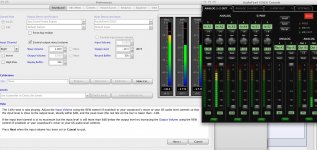 REW Preferences java during calib.jpg273.5 KB · Views: 753
REW Preferences java during calib.jpg273.5 KB · Views: 753 -
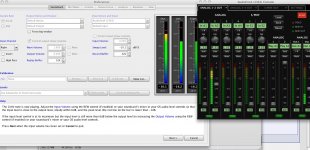 REW preferences default before calib.jpg281.4 KB · Views: 725
REW preferences default before calib.jpg281.4 KB · Views: 725 -
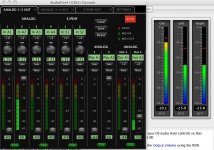 REW AF4 at -35.8dB.jpg152.8 KB · Views: 712
REW AF4 at -35.8dB.jpg152.8 KB · Views: 712 -
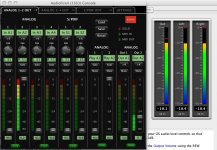 REW AF4 at -35.7dB.jpg158.2 KB · Views: 697
REW AF4 at -35.7dB.jpg158.2 KB · Views: 697 -
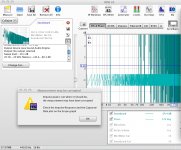 REW java meas may be corrupt.jpg162.3 KB · Views: 672
REW java meas may be corrupt.jpg162.3 KB · Views: 672 -
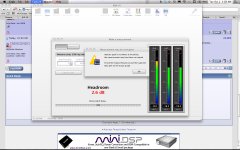 REW default meas may be corrupt.jpg240.8 KB · Views: 108
REW default meas may be corrupt.jpg240.8 KB · Views: 108
Last edited:
- Home
- Loudspeakers
- Subwoofers
- TH-18 Flat to 35hz! (Xoc1's design)
